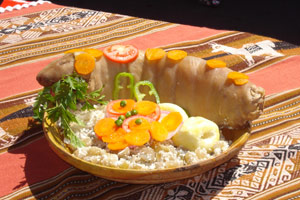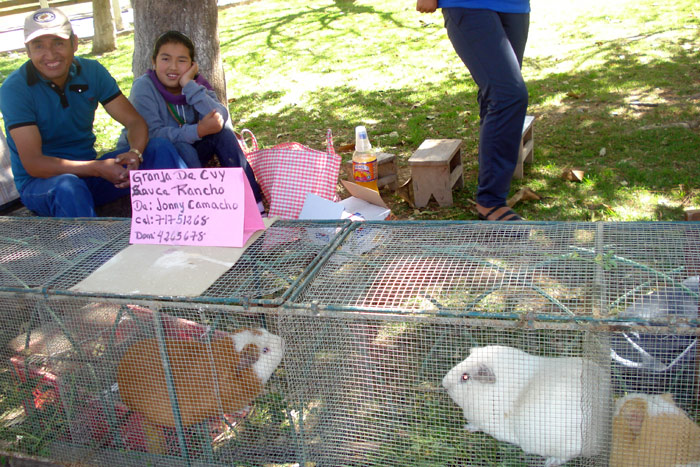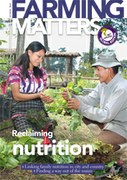The right to food sovereignty is a part of the Plurinational State of Bolivia’s constitution, but what does this actually mean for family farmers? The truth is that many people in rural areas are far from having access to adequate food and nutrition, with 37% of children under five reported to be suffering from stunting caused by malnutrition. Amongst the institutions and initiatives that aim to improve food security and sovereignty, the cuy (or guinea pig) project stands out for the inroads it has made towards improving food and nutrition at the family level.
Securing access to enough nutritious food is the major concern for most family farmers in Colomi, central Bolivia, and the recent rises in food prices have made things worse. Beef used to be an important source of animal protein, but the increasing cost of meat meant that people had to seek alternatives. In 2011, World Vision started the ‘cuy project’ to explore ways of improving the food security of family farmers by promoting the production and consumption of guinea pigs.
Benefits all round
Guinea pigs
The guinea pig (Cavia porcellus) is neither from Guinea nor a member of the pig family. This rodent, also known as cuy, cobayo and cavy in Latin America, was domesticated in pre-Columbian times, and is a well-known source of meat in Peru, Ecuador, Bolivia and southern Colombia. There are an estimated 36 million guinea pigs in this region, where they are an important source of food as well as having spiritual and medicinal value. They are also reports of increasing interest in guinea pigs as a potential source of meat elsewhere in the world.
As herbivores, guinea pigs naturally feed on large quantities of forage such as grasses, legumes, weeds and herbs. But they can also be fed on kitchen scraps and are very good processors of waste. Adult guinea pigs weigh between 1 and 2 kg and can provide a family’s protein needs for a day, though the meat is enjoyed for its taste as well as its nutritional value. The meat contains more than 20% protein, which is higher than in chicken, beef, lamb or pork. And with only about 8% fat, it is also leaner than most other common meats. It is also rich in Omega 3 fatty acids and Vitamin B, and as such is a healthier as well as cheaper alternative to other meats.
Guinea pig meat is high in protein and low in fat, and the little animals show great potential to improve the nutrition and livelihoods of farmers by providing food and income, but also in the wider community with more affordable meat for sale at local markets. In the farming families, children benefit most from the increased availability of fresh and nutritious meat from home-produced guinea pigs.
Consumers too benefit, being happy now to be able to buy guinea pig meat at local markets, particularly since the quality and hygiene has improved. Corina, a housemaid from downtown Cochabamba city said, “two years ago the presentation of guinea pigs at market was not very appealing, and people like me did not buy it even though I like the taste a lot.”
Another consumer at a local supermarket said enthusiastically that, “it is an innovation to find guinea pig meat at this supermarket, as it was looked down upon for many years.” And the meat is not only sold in local markets and supermarkets. Those involved in the project also sell 350 guinea pigs a week to local restaurants.
Breeding for success
For local women, i.e. those entrusted with the important task of feeding their families and supporting their children’s growth and development, the cuy project was an interesting proposition. It offered a new opportunity to produce protein-rich meat and to earn additional income.
A total of 38 families from Colomi joined the project. Each family received between two and four mating pairs, training in how to raise them, and initial support for buying cages, roofing material and supplementary feed. The training courses covered various aspects of animal management including how to separating them by age and gender, breeding and sanitation. Courses were organised as part of regular weekend meetings when most people were available. Jorge Ayala, a project coordinator, notes that “At the beginning, only a few people were interested in the meetings, but two weeks later more people started attending.” Over time, the meetings evolved into sessions where farmers would share their different experiences with, and approaches to, guinea pig farming.
Fitting the local context
Besides the increasing demand for improved access to affordable animal protein, there were a number of other reasons why the project had such a huge success.
It is no coincidence that guinea pigs are well suited to the local culture. Guinea pigs, one of the oldest domesticated animals in the Andean region, have been part of farmers’ diets and rituals for centuries.
All of the families were familiar with raising and eating guinea pigs and a number of families already kept a few. But breeding and eating guinea pigs still had a certain stigma attached to it, so much so that it was difficult to find traditionally knowledge on raising guinea pigs.
Learning within the project was strongly supported by the existing social bonds between the participating families. They were already part of a strong social network, with most being active members of their local church group. Others in the community also became interested and wanted to join. “I was interested in the project because I saw my neighbour’s experience with cuyes,” explains Eliana, one of the newer participants. Learning and experimenting as a group also made the experience much more manageable for many of them.
Compared to raising other livestock, breeding guinea pigs is a relatively easy venture to get off the ground. It requires little initial investment, and so most households can afford to make a start, at least with bas. Not much space is needed and the animals are docile and easy to handle. Producing guinea pigs demand little in terms of farm resources, and does not compete with other farm activities to any extent.
Building pride

For decades, farming guinea pigs was associated with poverty and a ‘low class’ diet. Many people still think of them only as rodents, vermin, eaten only by poor peasant farmers. These stigmas persist, but experiences in Colomi show that the tables are turning.
In August 2014, a fair was held in nearby Cochabamba city to promote guinea pig farming and the consumption of guinea pig meat. Animals from different regions were exhibited, with a cookery competition and taste testing between different guinea pig dishes. More events like this will help to further demystify the eating of guinea pig meat.
And from production…
Some families built cages, others used empty rooms at home if they had any, with each family taking their own, slightly different approach to housing. This was also the case with feeding, as many families started to experiment with different types of food. “At the beginning I used to feed my cuyes with kitchen scraps” said Celia, one of the farmers. “After I received training, I began using supplementary feeds which I mix with the kitchen scraps. This provides my cuyes with a better meal and it reduces my expenses.” All these and many more different experiences on feeding and housing were shared during project meetings, and this really helped with farmer to farmer learning.
Guinea pig farming really is a family affair. Often, adults in the household feed the guinea pigs early in the morning before work, leaving other tasks to children and older members of the household.
The number of animals kept depends on the size of the family as well as the availability of food. The amount of money that can be generated through the sale of guinea pigs is also a consideration when deciding how and where to invest resources into the family farm.
… to consumption
The link between production and consumption was strengthened by the active involvement of women, who made up most of those involved in the cuy project. Their main tasks used to be household chores, so breeding guinea pigs presented a huge opportunity for these women to produce meat for the family and earn extra money too.
Eliana is from from Sipe Sipe. Two years after the project started, she now has 110 guinea pigs, most of which she keeps for family consumption. Isabel Laime similarly divides her guinea pigs, “every three months, 60 new cuyes are born. I prepare 40 for family dinners and sell 20 at Sipe Sipe market.”
And increasing demand
Local families in Colomi are enjoying the increased access to nutritious animal protein and an additional source of income. But the positive impacts resulting from the cuy project are also being felt well beyond the initial project area, with guinea pig farming improving the nutrition of non-producing families.
“Meat quality has improved 100%,” says Jorge Ayala, involved in coordination of the project. Consumers are realising this and demand for guinea pig meat has begun to exceed supply, causing the prices to rise. Three years ago a 0.8 kg guinea pig was selling for US$1.15 on the local market, but today, an animal of the same weight will sell for as much as US$3.17. Local supermarkets are also selling around 3000 guinea pigs per week now, and which is expected to increase further in the future.
Nutritional impact
Nutritional improvements in Colomi resulted from the convergence of a local need and an initiative which was very well adapted to the local context. Also, the women who took up guinea pig farming facilitated the nutritional impact, as they were in a position to control the allocation of resources between food on their family’s plates and income for the household. The resulting resurgence of guinea pig meat production and consumption in Bolivia also holds promise for realising the potential of guinea pig production beyond the Andean region.
Eduardo Lopez Rosse A.
Eduardo Lopez Rosse A. is a PhD candidate at CIDES-UMSA and a technician at the Department of Consumer Defense at Gobierno Autonomo Municipal de Cochabamba, Bolivia.
Email: elopez@catie.ac.cr


